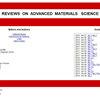Study on physical and mechanical properties of complex-phase conductive fiber cementitious materials
IF 3.6
4区 材料科学
Q2 MATERIALS SCIENCE, MULTIDISCIPLINARY
引用次数: 0
Abstract
With the continuous upgrading of infrastructure construction and the gradual development of theoretical research about engineering construction, higher performance requirements have been put forward for concrete materials. Therefore, to meet the engineering quality requirements of various concrete structures, the research direction of engineering materials has shifted towards developing new concrete with high strength, high ductility, high toughness, and other multifunctional properties. Mixing two or more types of fibers with conductive properties with the cement matrix material allows various fibers to leverage their strengths and weaknesses, thereby utilizing their respective characteristics. This results in the formation of a complex-phase conductive fiber cementitious material (CFCM), which enhances the safety, durability, and toughness of the structure. It enables the engineering structure to exhibit intelligence and resourcefulness, thereby improving its service life and reducing the full life cycle cost of the cementitious material structure. Additionally, this approach relatively eases the demand for concrete materials and reduces material consumption. This method represents one of the research directions for new concrete. Complex-phase CFCMs are essentially smart materials capable of sensing not only compressive or tensile stresses but also temperature. The emergence of CFCM represents a significant step forward in enhancing the mechanics, functionality, and sustainability of modern infrastructure. In this experiment, an orthogonal test involving 16 working conditions with three factors and four levels was designed, with steel fiber (SF) type, SF content, and carbon fiber (CF) content as the factors. The study focused on the physical and mechanical properties of composite conductive fiber cement-based materials containing both SF and CF. Performance indicators such as flexural strength, volume resistivity, and energized temperature rise of the composite conductive fiber cement-based materials were tested. The analysis of orthogonal tests produced the following results regarding the degree of influence of each factor on the mechanical and physical properties: the order of influence on flexural strength was SF doping > SF type > CF doping. Further analysis revealed that the best combination was复相导电纤维水泥基材料的物理和机械性能研究
随着基础设施建设水平的不断提高和工程建设理论研究的逐步发展,对混凝土材料的性能提出了更高的要求。因此,为满足各种混凝土结构的工程质量要求,工程材料的研究方向已转向开发具有高强度、高延展性、高韧性等多功能性能的新型混凝土。将两种或两种以上具有导电性能的纤维与水泥基体材料混合,可以使各种纤维扬长避短,从而发挥各自的特性。这样就形成了复相导电纤维水泥基材料(CFCM),从而提高了结构的安全性、耐久性和韧性。它使工程结构表现出智能性和资源性,从而提高其使用寿命,降低水泥基材料结构的全生命周期成本。此外,这种方法还能相对缓解对混凝土材料的需求,减少材料消耗。这种方法是新型混凝土的研究方向之一。复相 CFCM 本质上是一种智能材料,不仅能感应压应力或拉应力,还能感应温度。CFCM 的出现标志着在增强现代基础设施的力学、功能和可持续性方面向前迈出了重要一步。在本实验中,以钢纤维(SF)类型、SF 含量和碳纤维(CF)含量为因素,设计了一个涉及 16 种工作条件、三个因素和四个水平的正交试验。研究重点是含有 SF 和 CF 的复合导电纤维水泥基材料的物理和机械性能。测试了复合导电纤维水泥基材料的抗弯强度、体积电阻率和通电温升等性能指标。正交试验分析得出了各因素对力学和物理性能的影响程度:对抗弯强度的影响顺序为 SF 掺杂> SF 类型> CF 掺杂。进一步分析发现,最佳组合是 A4B4C4。各因素对电阻率的影响关系如下:碳纤维掺杂> SF掺杂> SF类型。比较各层次之间的权重,可以发现导电率方案的最佳组合也是 A3B4C4。SF 和 CF 分别提高了复相导电纤维水泥基材料的力学和物理性能。水泥基材料的温升试验结果表明,温升与导电率之间存在一定的关系。具体来说,导电率越高,观察到的温升就越大。通过对导电率的正交分析,不考虑不显著的影响因素 SF 类型对导电加热试验的影响,在 16 组条件下研究了 CF 掺杂和 SF 掺杂两个因素对加热试验的影响,并对数据进行了直观分析。通过正交分析和直观分析的综合优化,确定了试验的最佳混合比为 A3B4C4。这意味着,使用镀铜 SF(SF 用量为 1.25%,CF 用量为 0.48%)可获得最佳物理机械性能。作为智能混凝土领域的前沿研究,本实验探索了智能混凝土的研究路径,对后续更复杂的研究工作具有积极意义。
本文章由计算机程序翻译,如有差异,请以英文原文为准。
求助全文
约1分钟内获得全文
求助全文
来源期刊

Reviews on Advanced Materials Science
工程技术-材料科学:综合
CiteScore
5.10
自引率
11.10%
发文量
43
审稿时长
3.5 months
期刊介绍:
Reviews on Advanced Materials Science is a fully peer-reviewed, open access, electronic journal that publishes significant, original and relevant works in the area of theoretical and experimental studies of advanced materials. The journal provides the readers with free, instant, and permanent access to all content worldwide; and the authors with extensive promotion of published articles, long-time preservation, language-correction services, no space constraints and immediate publication.
Reviews on Advanced Materials Science is listed inter alia by Clarivate Analytics (formerly Thomson Reuters) - Current Contents/Physical, Chemical, and Earth Sciences (CC/PC&ES), JCR and SCIE. Our standard policy requires each paper to be reviewed by at least two Referees and the peer-review process is single-blind.
 求助内容:
求助内容: 应助结果提醒方式:
应助结果提醒方式:


